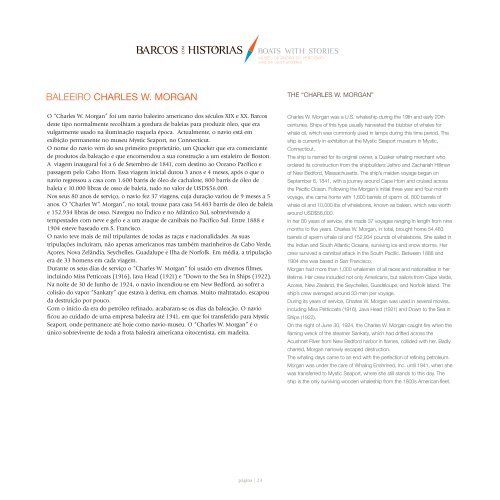Versão digital - Museu de Angra do Heroísmo
Versão digital - Museu de Angra do Heroísmo
Versão digital - Museu de Angra do Heroísmo
Create successful ePaper yourself
Turn your PDF publications into a flip-book with our unique Google optimized e-Paper software.
BALEEIRO CHARLES W. MORGAN<br />
O “Charles W. Morgan” foi um navio baleeiro americano <strong>do</strong>s séculos XIX e XX. Barcos<br />
<strong>de</strong>ste tipo normalmente recolhiam a gordura <strong>de</strong> baleias para produzir óleo, que era<br />
vulgarmente usa<strong>do</strong> na iluminação naquela época. Actualmente, o navio está em<br />
exibição permanente no museu Mystic Seaport, no Connecticut.<br />
O nome <strong>do</strong> navio vem <strong>do</strong> seu primeiro proprietário, um Quacker que era comerciante<br />
<strong>de</strong> produtos da baleação e que encomen<strong>do</strong>u a sua construção a um estaleiro <strong>de</strong> Boston.<br />
A viagem inaugural foi a 6 <strong>de</strong> Setembro <strong>de</strong> 1841, com <strong>de</strong>stino ao Oceano Pacífico e<br />
passagem pelo Cabo Horn. Essa viagem inicial durou 3 anos e 4 meses, após o que o<br />
navio regressou a casa com 1.600 barris <strong>de</strong> óleo <strong>de</strong> cachalote, 800 barris <strong>de</strong> óleo <strong>de</strong><br />
baleia e 10.000 libras <strong>de</strong> osso <strong>de</strong> baleia, tu<strong>do</strong> no valor <strong>de</strong> USD$56.000.<br />
Nos seus 80 anos <strong>de</strong> serviço, o navio fez 37 viagens, cuja duração variou <strong>de</strong> 9 meses a 5<br />
anos. O “Charles W”. Morgan”, no total, trouxe para casa 54.483 barris <strong>de</strong> óleo <strong>de</strong> baleia<br />
e 152.934 libras <strong>de</strong> osso. Navegou no Índico e no Atlântico Sul, sobreviven<strong>do</strong> a<br />
tempesta<strong>de</strong>s com neve e gelo e a um ataque <strong>de</strong> canibais no Pacífico Sul. Entre 1888 e<br />
1904 esteve basea<strong>do</strong> em S. Francisco.<br />
O navio teve mais <strong>de</strong> mil tripulantes <strong>de</strong> todas as raças e nacionalida<strong>de</strong>s. As suas<br />
tripulações incluíram, não apenas americanos mas também marinheiros <strong>de</strong> Cabo Ver<strong>de</strong>,<br />
Açores, Nova Zelândia, Seychelles, Guadalupe e Ilha <strong>de</strong> Norfolk. Em média, a tripulação<br />
era <strong>de</strong> 33 homens em cada viagem.<br />
Durante os seus dias <strong>de</strong> serviço o “Charles W. Morgan” foi usa<strong>do</strong> em diversos filmes,<br />
incluin<strong>do</strong> Miss Petticoats (1916), Java Head (1921) e “Down to the Sea in Ships (1922).<br />
Na noite <strong>de</strong> 30 <strong>de</strong> Junho <strong>de</strong> 1924, o navio incendiou-se em New Bedford, ao sofrer a<br />
colisão <strong>do</strong> vapor “Sankaty” que estava à <strong>de</strong>riva, em chamas. Muito maltrata<strong>do</strong>, escapou<br />
da <strong>de</strong>struição por pouco.<br />
Com o início da era <strong>do</strong> petróleo refina<strong>do</strong>, acabaram-se os dias da baleação. O navio<br />
ficou ao cuida<strong>do</strong> <strong>de</strong> uma empresa baleeira até 1941, em que foi transferi<strong>do</strong> para Mystic<br />
Seaport, on<strong>de</strong> permanece até hoje como navio-museu. O “Charles W. Morgan” é o<br />
único sobrevivente <strong>de</strong> toda a frota baleeira americana oitocentista, em ma<strong>de</strong>ira.<br />
página | 23<br />
THE “CHARLES W. MORGAN”<br />
Charles W. Morgan was a U.S. whaleship during the 19th and early 20th<br />
centuries. Ships of this type usually harvested the blubber of whales for<br />
whale oil, which was commonly used in lamps during this time period. The<br />
ship is currently in exhibition at the Mystic Seaport museum in Mystic,<br />
Connecticut.<br />
The ship is named for its original owner, a Quaker whaling merchant who<br />
or<strong>de</strong>red its construction from the shipbuil<strong>de</strong>rs Jethro and Zachariah Hillman<br />
of New Bedford, Massachusetts. The ship’s mai<strong>de</strong>n voyage began on<br />
September 6, 1841, with a journey around Cape Horn and cruised across<br />
the Pacific Ocean. Following the Morgan’s initial three year and four month<br />
voyage, she came home with 1,600 barrels of sperm oil, 800 barrels of<br />
whale oil and 10,000 lbs of whalebone, known as baleen, which was worth<br />
around USD$56,000.<br />
In her 80 years of service, she ma<strong>de</strong> 37 voyages ranging in length from nine<br />
months to five years. Charles W. Morgan, in total, brought home 54,483<br />
barrels of sperm whale oil and 152,934 pounds of whalebone. She sailed in<br />
the Indian and South Atlantic Oceans, surviving ice and snow storms. Her<br />
crew survived a cannibal attack in the South Pacific. Between 1888 and<br />
1904 she was based in San Francisco.<br />
Morgan had more than 1,000 whalemen of all races and nationalities in her<br />
lifetime. Her crew inclu<strong>de</strong>d not only Americans, but sailors from Cape Ver<strong>de</strong>,<br />
Azores, New Zealand, the Seychelles, Gua<strong>de</strong>loupe, and Norfolk Island. The<br />
ship’s crew averaged around 33 men per voyage.<br />
During its years of service, Charles W. Morgan was used in several movies,<br />
including Miss Petticoats (1916), Java Head (1921) and Down to the Sea in<br />
Ships (1922).<br />
On the night of June 30, 1924, the Charles W. Morgan caught fire when the<br />
flaming wreck of the steamer Sankaty, which had drifted across the<br />
Acushnet River from New Bedford harbor in flames, colli<strong>de</strong>d with her. Badly<br />
charred, Morgan narrowly escaped <strong>de</strong>struction.<br />
The whaling days came to an end with the perfection of refining petroleum.<br />
Morgan was un<strong>de</strong>r the care of Whaling Enshrined, Inc. until 1941, when she<br />
was transferred to Mystic Seaport, where she still stands to this day. The<br />
ship is the only surviving woo<strong>de</strong>n whaleship from the 1800s American fleet.



